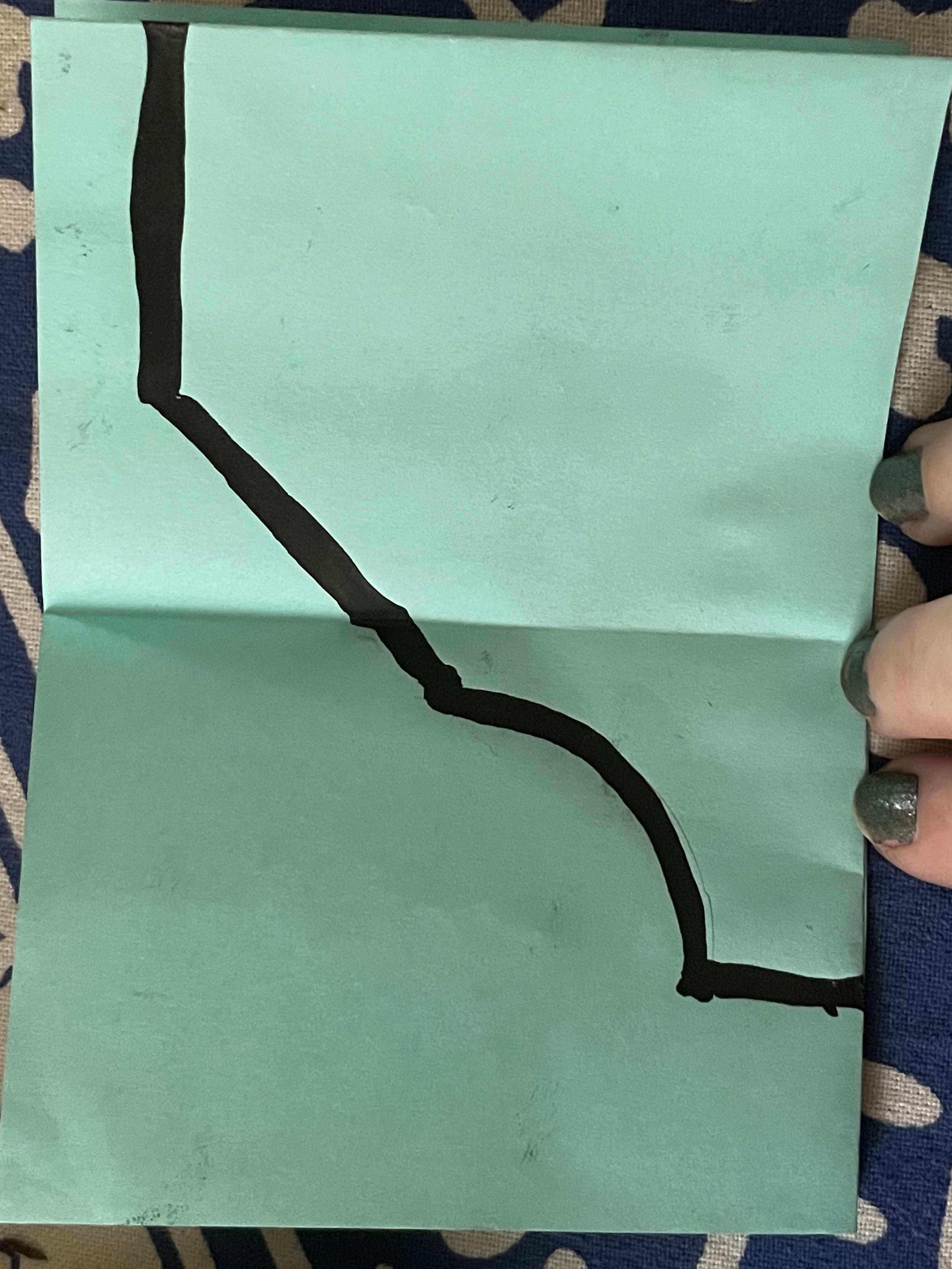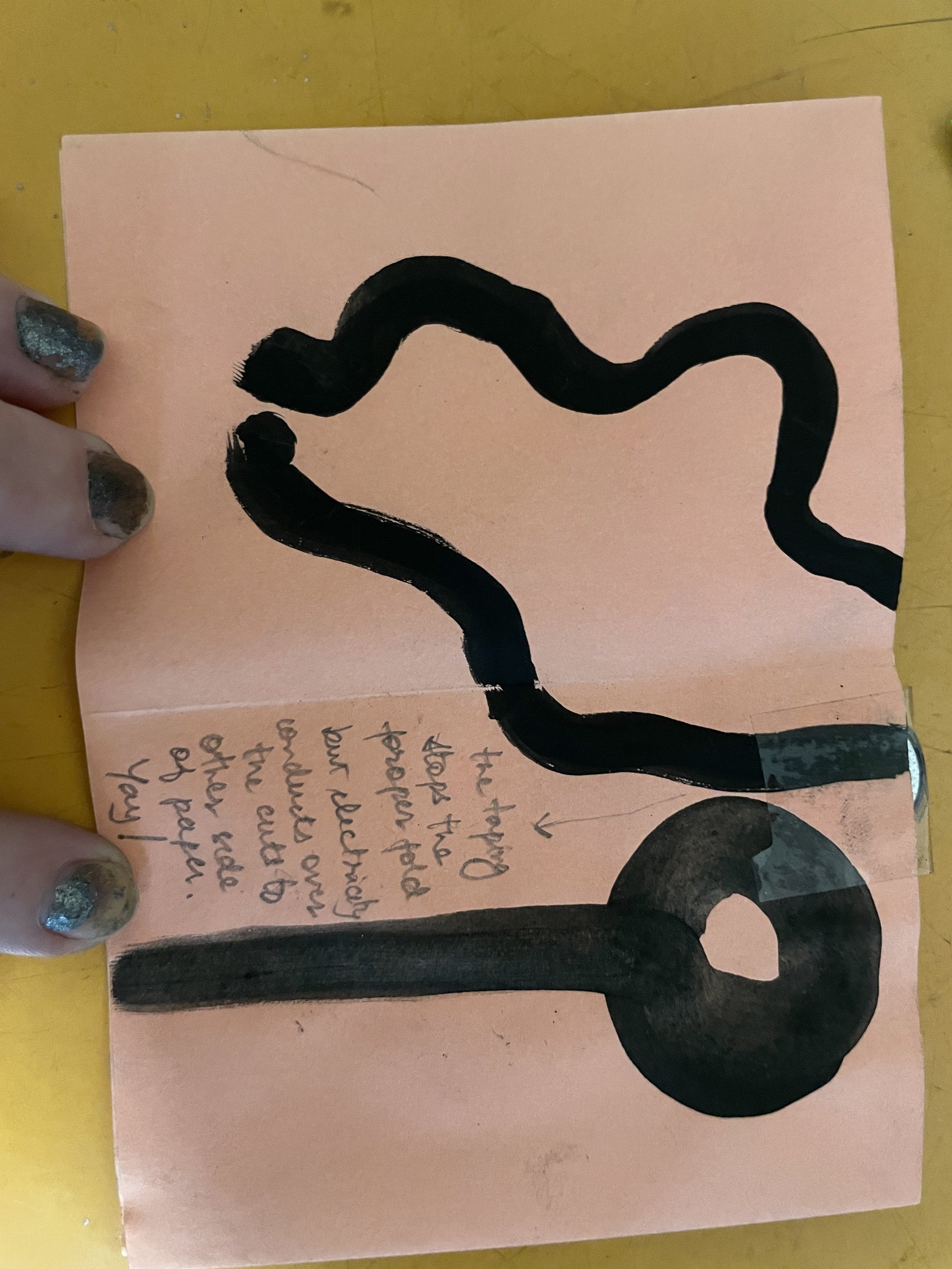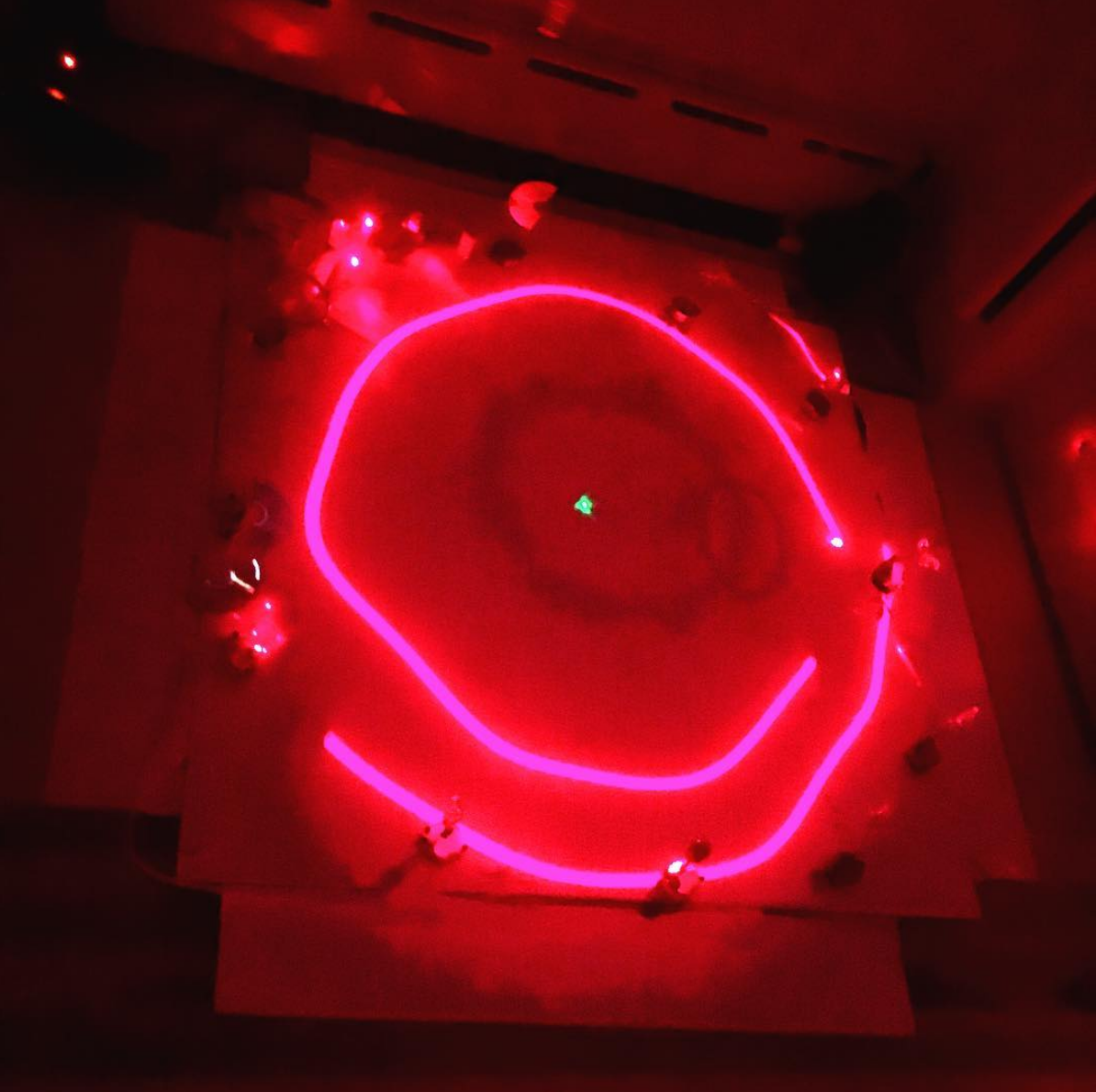
Custom Instruments
Hardware based instruments playing electromagnetic frequencies.
Heart sensors, wire tapping devices, electromagnetic pickups, LEDs, radio transmitters and receivers, phones, and microphones in feedback loops, all these components make up the instruments you see here and contribute to the unique sounds below. I am fascinated with the electromagnetic spectrum as a classical natural element like air, water, fire, etc. With these instruments and performances of them I hope to advance that notion and experience.
Bareëmins come in different shapes & sizes
Since the paint can be applied to paintings as well as the inside of paper and plastic sculptures the results are many fold.
There are folded paper crystal Bareëmins that look like crystals suitable for an electromagnetic altar. You can use them to invoke the Electromagnetic Goddess at home.
<- There are painted Bareëmins that look like beautiful illustrations. They are painted with conductive carbon paint, and non-conductive paint. When the area that is conductive is activated it produces sound, the non-conductive area does not. Thereby, by alternating painted and not painted areas in an aesthetic way, a score can be embedded into the very instrument itself.
The carbon paint is either bought conductive paint or made by recycling charcoal from a cooking fire, the colored paint is everyday school supplies and paint made out of found earth pigment. The binder is paste glue. The brains are an Arduino running simple theremin code with only 2 resistors and an 8ohm speaker as peripherals.
painted Bareëmins in particular are instruments that are also scores as the score is embedded in the antenna.
There are gold leaf painted Baeëmins which are more in the form factor of traditional icons
There are Bareëmins that are painted shells, sculls, and other bone objects.
There are Bareëmins that are made with copper tape in both 2D and 3D mediated by paint.
In the pursuit of artistic exploration, I've broken out of the 2 dimensional plane of the watercolor paper and delved into the realm of unconventional surfaces, including but not limited to shell, bones, and wood. This foray into diverse materials has been a captivating journey, unveiling the inherent potential of each surface as a unique substrate for creative expression. Whether it be the intricate contours of a shell, the organic textures of bone, or the solid yet malleable and sometimes porous nature of wood, every surface has emerged as a viable medium for the antenna making process, and responds with its own unique characteristics.
instructions v
Recordings of EM KVLT using Bare-mins
You can embed a score in a Bareëmin by painting it directly on a sheet of paper.










Bones & Sculls
The assembly of the crystal Bareëmin
Somewhere I recorded the gluing part too : ) But this is the structure that goes on the inside of a crystal Bareëmin. The holographic crystal Bareëmins have the same shape of antennae inside but made with copper tape.
Science Writer Ipsa Jain and I made a zine workshop to demonstrate the use of the paint. The zine is both its own documentation, and (sometimes) an interactive book-type object making it a really unique artifact.
Crystal Bareëmins
Crystal Bareëmins, and painted ones being played at CCX in upstate New York. If you listen carefully at some point you can hear the birds singing along with us. I’ve never met a group of birds as interested in interacting with musicians as these. They feature prominently on the dance stages at this festival as well.
EM KVLT is Sofya Yuditskaya, Meg Schedel, and Imonni Cole sitting in for Jess Rowland.


























Gold Leaf Bareëmins
The form factor adopted by Guilded Bareëmins closely resembles that of traditional icons, with techniques shared across Christian, Buddhist, and Hindu lineages. Here, the gold leaf is intentionally left exposed to leverage its inherent conductivity, transforming it into a functional antenna. The material's resistance to corrosion, owing to gold's non-reactive (that is, it won’t rust) nature, ensures that the exposed gold leaf remains durable over time. The incorporation of classic icon-making techniques into the Bareëmin project represents a compelling addition, offering an entire school of craftsmanship with its rich history, techniques, and conceptual frameworks. By integrating these well-established practices, the Bareëmin project becomes more than an individual artistic endeavor; it evolves into a collective effort that invites a community of makers with a priori knowledge to actively participate. This intentional alignment with historical icon-making traditions not only pays homage to artistic heritage but also facilitates a seamless integration of diverse maker communities into the Bareëmin project, fostering a multidimensional and collaborative engagement with the instrument.
Copper tape can also be used to extend a sculptural or environmental Bareëmin such as in the case of the dodecaOTTO collaboration with Tamlab Linz. Its use in Bareëmin construction attests to this reliability and confirms its adaptability across various artistic forms. With the use of copper tape and/or aluminum tape (when copper tape is not available) I have made fully 3D stained glass structures to act as Bareëmin antennae, cards that could act as painted scores, and zines that convey a narrative as well as connectivity through circuitry for Bareëmin activation. See below v
Copper Tape & Carbon Paint
Using a theremin board ^^ vs. rolling your own w/ Arduino ->
Theremins using bare conductive paint and copper tape to create the antenna. To the left you can see the first iteration, made using a theremin kit. Below, you can hear the sound they make. I have since replaced the hardware with an Arduino, the output, interestingly, is exactly the same.
Bareëmin Paintings
Markov Magic Circles
Three Magic Circles are arranged on the stage. The magic circle represents a border condition between the chaos of the outside world and the safe space within. A magic circle usually protects the person in it by keeping bad energies out, or it summons an entity using its codified energies.The magic circles are animated by Markov chains, deterministic probability structures generated by an algorithm to sound like there is someone there. Perhaps the performance will summon a ghost from the machine. Performers play by activating “gear” with em microphones. No gear or processing is actually used in the piece, we only the natural emissions of electronic waves from the various sleeping devices making up the Magic Circles of our digital lives.
Three Magic Circles are arranged on the stage. The magic circle represents a border condition between the chaos of the outside world and the safe space within. A magic circle usually protects the person in it by keeping bad energies out, or it summons an entity using its codified energies.The magic circles are animated by Markov chains, deterministic probability structures generated by an algorithm to sound like there is someone there. Perhaps the performance will summon a ghost from the machine. Performers play by activating “gear” with em microphones. No gear or processing is actually used in the piece, we only the natural emissions of electronic waves from the various sleeping devices making up the Magic Circles of our digital lives.
From MIT’s Computer Music Journal:
Sofy Yuditskaya’s installation Markov Magic Circles was a celebration of female power. The magic circles in this project are a digital interpretation of the magic circles in Gogol’s “Vie,” a fable about a witch getting the best of a seminary student who abused his place in society. This piece used a Markov prediction algorithm to flip virtual coins in order to activate three large LED rings. Based on the three salt rings in Gogol’s “Vie” the installation creates an atmosphere of an invocation, summoning unknown presences with pattern and repetition, all while trapping the listener in a brutal soundscape, an extended stay in self-determining probability cycles. The conceptual strength of directly amplifying the electromagnet transduction of the LEDs as sound sources made the link between image and sound very clear, and while the curatorial choice of putting it in another building than the conference was at first surprising, walking over there with fellow attendees created a sense of adventure and camaraderie.
Markov Magic Circles are a sculptural, hardware and software instrument. A circle of LEDs is mounted inside a PVC tube. This LED circle is controlled by signals sent from Pure Data running on a computer via serial over USB to Arduino and finally transferred to the WS2812b chips that control the LEDs. The LED circles can be triggered to play a variety of pre programmed light patterns. These light patterns are picked up by EM (electro-magnetic) microphones that are mounted on the LED circles and their power supplies. The signals from the EM microphones are sent back to Pure Data for additional processing, and finally sent out into the room via a sound system and to VDMX for the generation of projected visuals, which are projected into the room via digital projector.
The Pure Data patch has a timeline that triggers different behaviours in the instrument. It also allows for live interaction both while and instead of using the triggered behaviours. The instrument can be hacked at any time if one so desires. I must note that the instrument is mostly designed for my own use and I am not concerned with optimizing it for production or playability, it is a project with a user base of one or two and so it is highly idiosyncratic. It is not in any form of production though I will make for others to have their own it on request. Mostly its purpose is to be a piece specifically made for exploration in the space described below.
The LED Circle and its EM microphones are the core of this performance instrument. The software and processing can change, and even the microphones can be moved, but the LEDs on the strip are the voices in this choir and the keystone in this assemblage of parts creating a singular thing. Having relied on the assemblage or bricolage technique, the instrument is mostly technologically agnostic, it is a reflection of the artist’s life and what they had access to in the moment. At the core of this piece is a fascination with the inherent sound in a circle of light, and an interest in exploring the spectrum between free will and pre-destination, or improvisation and composition.
The first section of the performance does not have a body in it. The magic circles are animated by Markov chains, deterministic probability structures generated by an algorithm to sound like there is a body endowed with free will present within the circle. The software itself is the performer summoning its human spirits.
The sound of the LED Choir is created by electromagnetic microphones placed on the integrated chips of the LED strip and on the circuitry of its power adapters. The process of converting electricity to light through the use of code and circuitry is one that emits electromagnetic radiation. The electromagnetic microphones capture this radiation and convert it into sound. By sending a visual composition to the 150 LEDs in each strip I am able to make each LED emit a different tone (matching the color it is emitting at any one time), resulting in a choir of 150 LEDs. The tones the LEDs emit are louder and more high pitched when their colors are brighter and more mixed and quieter and lower pitched when they are darker and more say distinctly red, or blue. The sound itself has a fuzzy quality reminiscent of radio static, which fits snuggly into the family of sounds electromagnetic microphones tend to pick up. There are unexpected harmonies that emerge from the circles, having to do perhaps with the distance of the LEDS from each other, or the quantity of LEDs overall. There is still much left to explore with this setup.
The second part of the performance introduces human will. It includes three witches playing with electronic power transducers. Witchcraft is an anti-hierarchical, anti-structural, oral history-based practice; and so the witches in my instrument serve as the ultimate embodiment of free-will and manifestation of their personal desires by ‘will’ alone rather than as per composer dictates. Metaphor and ritual are also used in my instrument.
Perhaps the performance will summon a ghost from the machine. Markov postulated his ideas on probability as a rebuttal to mathematician and theologian Nekrasov, who believed so fervently in the concept of free will that he extended it to inanimate objects. (Today Markov chains are used in statistical analysis, neural networks, and AI. If an AI makes an independent decision perhaps it has free will—and so Markov would be proving Nekrasov correct despite proving him wrong.)
Eleven minutes or so of the performance happen within the three circles using no performers. This truth is conveyed to the audience via light and projection mapping. The next 11 minutes happen with one performer in the middle circle, as the ‘ghost’ summoned by the algorithm. The performer in the middle circle enacts the movements dictated to her by the Markov algorithm activating the various electronic devices in the circle. Once her enactment of the algorithm is complete she becomes inert for the next 11 minutes while two more performers step into the outer circles and perform the same composition. However, this time they have the option of interpreting the dictates of the algorithm. They thus enact a counterpoint of free will that responds somehow to the set of learned causalities. Finally, the last portion of the piece is a riotous culmination of free will exercise in its inclusion of acting on the hardware itself. The dismantling of the instrument is the natural conclusion of the work.
Performers:
Sofy Yuditskaya
Jess Rowland
Meg Schedel
Picture reference:
https://www.instagram.com/p/BeksG3ZD-vb
https://www.instagram.com/p/Bee1qLvj5Ez
https://www.instagram.com/p/BfaxwtujaSS
https://www.instagram.com/p/BeprAsWjFeo
Presented by NIME Porto Allegre, Abrons Art Center
LED Choir
Each LED is a voice singing in this choir. The visual patterns it creates are a choral composition, immediately rendered into sound by the electronic pickups at the end of the string of lights. Below is the first performance of it at NYU in the series "Squaring the Circle". And installation within an installation, here Tim Bruniges set up a complex feedback network in a room for musicians to perform in.
FM Synthesis
A feedback instrument made by receiving and transmitting on the FM dial within the same room. Interfering objects are placed between the receiver and transmitter
WoWiWa
Made with Valeria Morracco and Dan Wilcox. We mapped every known streaming station on the Web, that we could find at the time onto a 3D Spinning Globe in Processing. Dancer Valeria Morracco performed the visualization in a special costume that would rotate and spin the stations around triggering various streams as her own body crosses with the zenith of the room. Made and presented at the Netherland Institute Vor Media Kunst.
Relativity Too
You can see a clear demo of the heart sensor part of the rig here.
For Relativity
An EEG and Biofeedback expanded 3-D mandala. The EEG connects with a synthesizer in this case rather than a pre-composed track.




















